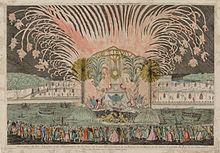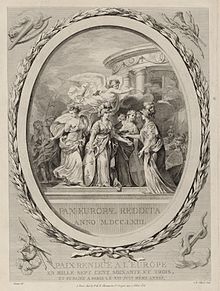Treaty of Paris (1763)
The Peace of Paris on 10 February 1763 ended the Seven Years' War in Western Europe, North America and India, which Great Britain and its ally Portugal had fought against France and Spain. This mainly affected territories in the Lower Rhine-Westphalia, Upper Rhine and Lower Saxony Imperial Circles, as well as the American, African and Indian colonies. Shortly afterwards, the Peace of Hubertusburg also ended the war between Prussia, the Empress Maria Theresa (Empire and Habsburg lands) and Electoral Saxony.
Britain had emerged as the sole winner from the conflict, particularly from the French and Indian War in North America. The peace treaty awarded England Florida, which had been Spanish until then. France had to cede Canada and the territories east of the Mississippi and around the Great Lakes to the British Crown. In addition, it had to compensate Spain with its territories west of the Mississippi (Louisiana) for the loss of Florida. In North America, France thus retained only the western half of the Caribbean island of Hispaniola (today's Haiti) and the fishing islands of Saint-Pierre and Miquelon, which, however, could not be fortified under the terms of the treaty.
France's Indian possessions also fell to Britain after the Third Carnatic War as a result of the Peace of Paris. The French Crown retained only a few trading posts here, including Pondicherry and Karikal, which became Indian in 1954. Senegambia, now divided into Senegal and Gambia, and some smaller possessions also became British. France had to remove the heavy fortifications of the port city of Dunkirk. Some provisions of the treaty were revised 20 years later in the Peace of Paris of 1783: After Britain's defeat in the American War of Independence, in which France had supported the fledgling United States against Britain, Senegal reverted to France and Florida to Spain.
After the conquest of Spain during the Napoleonic Wars, Louisiana also came under French rule again for a short time in 1800. Three years later, Napoleon I sold the entire territory to the United States (Louisiana Purchase).

Peep-show of the peace celebration in Paris: fireworks and ephemeral festive architecture on the Place Louis XV on 22 June 1763 on the occasion of the conclusion of peace and the inauguration of the equestrian statue of the King

Allegorical copper engraving: The peace restored to Europe in 1763. In front of the temple of Janus the personifications of France and Great Britain exchange olive branches under the supervision of Europe (right), while on the left Pax rushes over.
Search within the encyclopedia